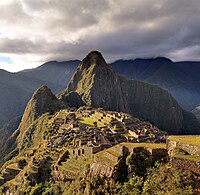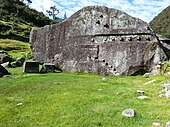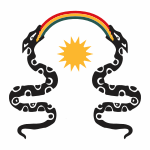Neo-Inca State
This article needs additional citations for verification. (November 2018) |
Realm of the Four Parts (Neo-Inca State) Tawantinsuyu ( Quechua ) | |||||||||||
|---|---|---|---|---|---|---|---|---|---|---|---|
| 1537–1572 | |||||||||||
|
Inca imperial banner | |||||||||||
Túpac Amaru I | |||||||||||
| Historical era | Early modern | ||||||||||
• Manco Inca Yupanqui created the Neo-Inca state of Vilcabamba | 1537 | ||||||||||
• Treaty of Acobamba | 1566 | ||||||||||
• Spanish conquest led by Francisco de Toledo | 1572 | ||||||||||
| |||||||||||
| Today part of | Peru | ||||||||||
 |
| Inca Empire |
|---|
| Inca society |
|
| Inca history |
The Neo-Inca State, also known as the Neo-Inca state of Vilcabamba, was the Inca state established in 1537 at
History
Inca retreat to Vilcabamba
The Vilcabamba region had been part of the
When Pizarro left Cuzco with Almagro and Manco Inca, for
Manco coordinated his siege of Cusco with one on Lima, led by one of his captains, Quiso Yupanqui. The Incans were able to defeat four relief expeditions sent by Francisco Pizarro from Lima. This resulted in the death of nearly 500 Spanish soldiers. Some Spaniards were captured and sent to Ollantaytambo. However, with the Spaniards' position consolidated by Almagro's reinforcements, Manco Inca decided that Ollantaytambo was too close to Cusco to be tenable so he withdrew further west.
Coexistence with Spain
At Vilcabamba the state known as the Neo-Inca State was established by Manco, and Vilcabamba became the capital of the state until the death of

Manco was succeeded by his son Sayri Túpac (Sayri Tupaq). He was five years old at the time. He became Inca in Vilcabamba, reigning for ten years with the aid of regents. This was a time of peace with the Spanish. Viceroy Pedro de la Gasca offered to provide Sayri Túpac with lands and houses in Cuzco if he would emerge from the isolated Vilcabamba. Sayri Túpac accepted, but during the preparations his relative Paullu Inca suddenly died. This was taken as a bad omen (or a sign of Spanish treachery), and Sayri Túpac remained in Vilcabamba. In 1557 Sayri Túpac did agree to leave Vilcabamba and traveled to Viceroy Hurtado in Lima. Sayri Túpac renounced his claim to the Inca Empire and accepted baptism, as Diego. In return he received a full pardon, the title of Prince of Yucay, and great estates with rich revenues. He became resident in Yucay, a day's journey northeast of Cuzco. Significantly, he left behind the royal red fringe, symbol of his authority.
In 1561, Sayri Túpac died suddenly, and his half-brother
Final conquest

Within two weeks after the declaration of war a small party of Spanish soldiers had captured a key bridge on the border of the Neo-Inca State, from which Toledo assembled his army. On June 1, the first engagement of the war commenced in the Vilcabamba valley. The Inca initially attacked with high morale, despite being poorly equipped. Repeatedly, the Inca attempted to lift the siege held by the Spanish and their native allies but were forced to retreat. On June 23 the fort of Huayna Pucará surrendered to Spanish artillery fire. The Inca army now in retreat opted to abandon their last city and head for the jungle to regroup. On June 24 the Spanish entered Vilcabamba to find it deserted and the Sapa Inca gone. The city had been entirely destroyed and the Neo-Inca State officially ceased to exist. Túpac Amaru was later captured and executed by the Spanish.
Adoption of Spanish warfare
The Inca military was swift in adopting European weaponry; many warriors captured helmets, shields, and swords during the initial clashes with the Europeans and quickly learned how to utilize them. In marked contrast to some other Native American cultures, such as the Aztecs, the Incas were also eager to master weaponry which was wholly "alien" to them.[6] As early as 1537, when Manco Inca defeated the Spanish at Pilcosuni, they came into possession of more advanced Spanish weapons, including arquebuses, artillery, and crossbows.[7] By the later stages of the Siege of Cusco, the Spaniards were already reporting that the Inca warriors were using captured firearms as well as horses with some proficiency. Manco Inca even forced captured Europeans to refine gunpowder for his army.[6]
The Incas also tried to adopt some European battle tactics: On at least one occasion, a group of Inca warriors formed a tight unit in combat, based on the teachings of a captured Spaniard, and used their bows, slings, and darts in a way to achieve more rapid fire.
In the early 1540s, several Spanish refugees would teach Incan warriors how to use Spanish weapons to their full potential.[11] Overall, it took the Incas approximately two decades to bridge the technological gap with the Spanish. By the 1560s, it was recorded that many Incans had developed considerable skill in utilizing arquebuses and riding horses.[7]
See also
References
- ^ Lee 2018, p. 743.
- ISBN 9781235937859
- ^ Hemming 1970, p. 222.
- ISBN 9780872208438
- ^ Bauer, Santa Cruz & Silva 2015, xxiii.
- ^ a b Sheppard 2021, p. 41.
- ^ a b Lynch 2001, p. 42.
- ^ a b Sheppard 2021, p. 42.
- ^ Hemming 1970, pp. 239–240.
- ^ Sheppard 2021, p. 84.
- ^ Hemming 1970, p. 274.
Works cited
- Hemming, John (1970). The Conquest of the Incas. Mariner Books. ISBN 9780156028264.
- Lee, Vincent R. (2018). "Vilcabamba: Last Stronghold of the Inca". In Sonia Alconini; R. Alan Covey (eds.). The Oxford Handbook of the Incas. Oxford University. pp. 741–758. ISBN 9780190219352.
- Lynch, J. (2001). Latin America Between Colony and Nation: Selected Essays. Palgrave Macmillan. ISBN 978-0333786789.
- Bauer, Brian S.; Santa Cruz, Javier Fonseca; Silva, Miriam Aráoz (2015). Vilcabamba and the Archaeology of Inca Resistance. The Cotsen Institute of Archaeology. ISBN 978-1938770036.
- Sheppard, Si (2021). Cuzco 1536–37: Battle for the Heart of the Inca Empire. Osprey Publishing. ISBN 978-1472843807.
Further reading
- Bauer, Brian S.; Halac-Higashimori, Madeleine; Cantarutti, Gabriel E. (2016). Voices from Vilcabamba. Accounts Chronicling the Fall of the Inca Empire. University Press of Colorado. ISBN 978-1607324256.
- Kubler, George (1947). "The Neo-Inca State (1537–1572)". The Hispanic American Historical Review. 27 (2). Duke University: 189–203. .


